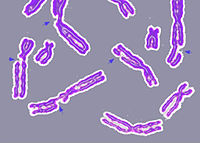
Photo from wikipedia
DNA interstrand cross-links (ICLs) prevent DNA replication and transcription and can lead to potentially lethal events, such as cancer or bone marrow failure. ICLs are typically repaired by proteins within… Click to show full abstract
DNA interstrand cross-links (ICLs) prevent DNA replication and transcription and can lead to potentially lethal events, such as cancer or bone marrow failure. ICLs are typically repaired by proteins within the Fanconi Anemia (FA) pathway, although the details of the pathway are not fully established. Methods to generate DNA containing ICLs are key to furthering the understanding of DNA cross-link repair. A major route to ICL formation in vivo involves reaction of DNA with acetaldehyde, derived from ethanol metabolism. This reaction forms a three-carbon bridged ICL involving the amino groups of adjacent guanines in opposite strands of a duplex resulting in amino and imino functionalities. A stable reduced form of the ICL has applications in understanding the recognition and repair of these types of adducts. Previous routes to creating DNA duplexes containing these adducts have involved lengthy post-DNA synthesis chemistry followed by reduction of the imine. Here, an efficient and high-yielding approach to the reduced ICL using a novel N2-((R)-4-trifluoroacetamidobutan-2-yl)-2′-deoxyguanosine phosphoramidite is described. Following standard automated DNA synthesis and deprotection, the ICL is formed overnight in over 90% yield upon incubation at room temperature with a complementary oligodeoxyribonucleotide containing 2-fluoro-2′-deoxyinosine. The cross-linked duplex displayed a melting transition 25 °C higher than control sequences. Importantly, we show using the Xenopus egg extract system that an ICL synthesized by this method is repaired by the FA pathway. The simplicity and efficiency of this methodology for preparing reduced acetaldehyde ICLs will facilitate access to these DNA architectures for future studies on cross-link repair.
Journal Title: Journal of the American Chemical Society
Year Published: 2022
Link to full text (if available)
Share on Social Media: Sign Up to like & get
recommendations!